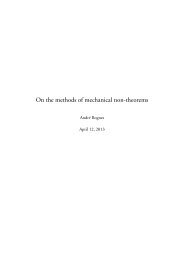Clausal architecture and movement verbs in Malagasy
Clausal architecture and movement verbs in Malagasy
Clausal architecture and movement verbs in Malagasy
Create successful ePaper yourself
Turn your PDF publications into a flip-book with our unique Google optimized e-Paper software.
<strong>Clausal</strong> <strong>architecture</strong> <strong>in</strong> <strong>Malagasy</strong><br />
In this section, we identify <strong>and</strong> illustrate the different tense-makers as well as<br />
the aspect-markers found <strong>in</strong> this language. The tense system shows a three-way<br />
dist<strong>in</strong>ction, whereas aspect <strong>in</strong>volves only a two-way dist<strong>in</strong>ction.<br />
3.1.1 <strong>Malagasy</strong> tense<br />
<strong>Malagasy</strong> tense represents a three-way formal system:<br />
(11) M-an-deha i Paoly.<br />
Pres-Prf-go Art Paul<br />
‘Paul goes.’<br />
(12) N-an-deha i Paoly.<br />
Past-Prf-go art Paul<br />
‘Paul went.’<br />
(13) H-an-deha i Paoly.<br />
Fut-Prf-go Art Paul<br />
‘Paul will go.’<br />
In the active voice, 11 the present tense marker is m-, the past tense marker is n<strong>and</strong><br />
the future tense marker is h-, as illustrated respectively <strong>in</strong> (11), (12) <strong>and</strong> (13)<br />
above. Note that, as was <strong>in</strong>dicated <strong>in</strong> R<strong>and</strong>riamasimanana (1997), <strong>in</strong> the passive<br />
voice the past tense marker could take the form no, whereas the future tense<br />
marker could look someth<strong>in</strong>g like ho. In addition, <strong>in</strong> the present tense <strong>in</strong> the<br />
passive voice, the marker is ∅.<br />
3.1.2 <strong>Malagasy</strong> aspect<br />
<strong>Malagasy</strong> aspect typically is a two-way formal system (i) whether we deal<br />
with nonverbal predicates like those illustrated <strong>in</strong> (14) <strong>and</strong> (15) below or (ii)<br />
whether we deal with verbal predicates that are transitive like those <strong>in</strong> the<br />
sentences shown <strong>in</strong> (16) <strong>and</strong> (17) or (iii) whether we deal with verbal predicates<br />
that are <strong>in</strong>transitive like those <strong>in</strong> (18) <strong>and</strong> (19) below:<br />
11 As expla<strong>in</strong>ed <strong>in</strong> R<strong>and</strong>riamasimanana (1997), the tense prefixes found <strong>in</strong> the active voice be<strong>in</strong>g<br />
functional heads behave rather differently from passive affixes with respect to case-assignment.<br />
For <strong>in</strong>stance, they do not carry case <strong>and</strong> do not assign case to the subject of the clause. As<br />
such, Empty Categories are permissible under the present tense, the future tense <strong>and</strong> the past<br />
tense <strong>in</strong> the active voice, especially <strong>in</strong> an embedded clause position, as <strong>in</strong> (45) <strong>and</strong> (46). In a<br />
matrix clause, however, there is always the possibility of hav<strong>in</strong>g an AGR(eement) projection<br />
<strong>in</strong>volv<strong>in</strong>g lexical items such as ity ‘this, s<strong>in</strong>gular’ <strong>and</strong> ireto ‘these, plural’ <strong>and</strong> so on. See<br />
opus cited for further detail.<br />
–517–

















